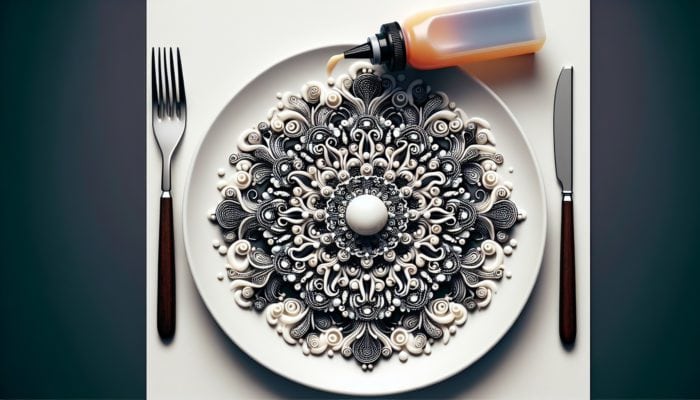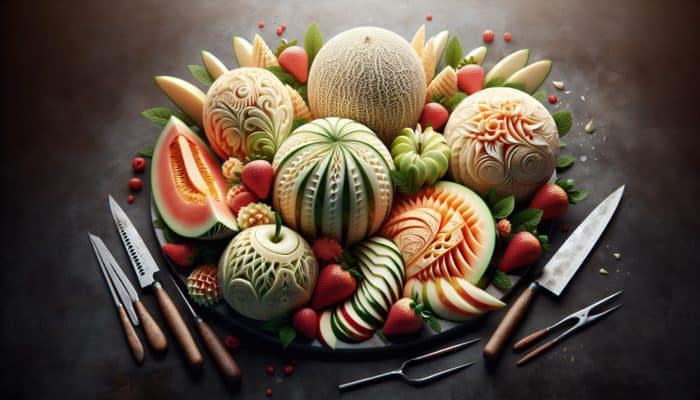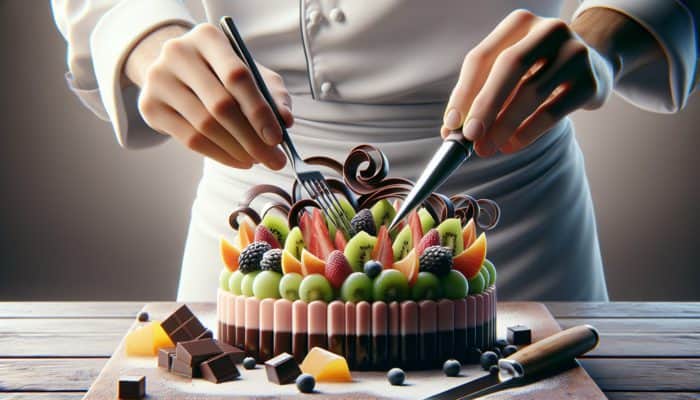Master the Art of Garnishing to Create Stunning Desserts That Dazzle
Crafting Striking Patterns with Simple Syrup for Dessert Elegance

To elevate your desserts, mastering the technique of garnishing with simple syrup can significantly enhance their visual appeal. This method allows for creativity and precision, making it accessible for anyone looking to impress their guests with visually stunning presentations. The key to success lies in achieving the right syrup consistency; it should be thick enough to retain shapes while still being fluid enough to flow smoothly. Consider using a squeeze bottle or piping bag for creating intricate designs. Here are some effective techniques to remember when working with simple syrup:
- Swirls: Create mesmerizing spiral patterns on the plate.
- Lines: Opt for long, straight lines to achieve a sleek, modern aesthetic.
- Dots: Distribute small dots of syrup around your dessert for a whimsical touch.
- Grids: Design a grid pattern for a more artistic presentation.
- Heart Shapes: Pour syrup into heart shapes for a romantic touch.
- Lettering: Personalize desserts by writing messages or initials.
- Layering: Use various syrup colors for beautiful layered visuals.
- Backgrounds: Create an abstract background to accentuate the main dessert.
With regular practice, simple syrup designs can drastically improve your plating skills, transforming ordinary desserts into captivating art pieces that tell a story. Experiment with different color combinations by integrating natural food colorings or flavor-infused syrups, ensuring that the visual presentation perfectly complements the dessert’s flavors.
Enhancing Dessert Appeal with Luxurious Chocolate Curls and Shavings
Chocolate curls and shavings add a layer of decadence to desserts, elevating both their taste and visual charm. The best chocolate types for garnishing are high-quality varieties with a balanced cocoa content. Dark chocolate, with cocoa content between 60% to 70%, imparts a rich flavor, while milk chocolate adds sweetness and creaminess. White chocolate can also offer a lovely contrast when combined with darker chocolates, creating a delightful balance.
To create beautiful chocolate curls, use a vegetable peeler on a block of tempered chocolate. Firmly hold the chocolate and glide the peeler along the edges to produce delicate curls. For shavings, a grater works wonderfully, allowing you to create fine flakes. Alternatively, melt the chocolate and spread it thinly on parchment paper. Once cooled, roll it up to form stunning curls. Remember, the secret to successful chocolate garnishing lies in properly tempering your chocolate, ensuring a glossy finish and a delightful crisp texture that everyone craves.
Incorporating Edible Flowers for a Sophisticated Touch and Unique Flavor
Adding edible flowers to your dessert garnishes not only introduces vibrant colors but also brings unique, delicate flavors to the table. When selecting flowers, it’s essential to ensure they are safe for consumption. Always source them from reputable suppliers and avoid those treated with harmful pesticides or chemicals. Popular edible varieties, including nasturtiums, pansies, and violets, add both aesthetic beauty and taste enhancement to your desserts.
Before using edible flowers, gently rinse them under cold water and pat them dry. Consider their size and shape for garnishing; larger blooms can beautifully adorn the top of a cake, while smaller ones can be scattered around the plate or used to create a colorful border. Pairing edible flowers with complementary flavors can elevate the overall taste experience. For example, lavender pairs wonderfully with lemon, while hibiscus harmonizes beautifully with chocolate. A little creativity ensures these floral garnishes are just as delightful to the palate as they are visually stunning.
Turning Ordinary Fruits into Artful Garnishes with Carving Techniques

The timeless skill of fruit carving can transform ordinary fruits into exquisite garnishes, greatly enhancing the aesthetic value of your desserts. Essential tools for successful fruit carving include a sharp knife, a vegetable peeler, and specialized carving tools such as melon ballers and offset spatulas. Familiarize yourself with fruits that are particularly well-suited for carving, such as melons, apples, and strawberries, as these yield impressive results when crafted skillfully.
Start with fundamental techniques, like creating petal shapes from apple slices, and progress to more intricate designs, such as swans carved from watermelon. For advanced creations, consider structured pieces like fruit baskets or floral arrangements. Seek inspiration from traditional fruit carvings seen in cultures like Thailand, where this art form is highly esteemed. Always keep your fruit fresh and your knife sharp, as this ensures clean cuts and prevents bruising. The beauty of fruit carving lies in its adaptability; with dedication and practice, you can create breathtaking, edible art that elevates any dessert to extraordinary heights.
Expert Strategies to Enhance Your Dessert Garnishing Skills
Inspiring Real-World Examples of Successful Dessert Garnishing
A captivating garnish has the power to transform a simple dessert into a breathtaking masterpiece. For example, take a classic chocolate mousse topped with rich chocolate curls and a sprinkle of sea salt; this simple enhancement not only adds texture but also creates a striking contrast between the smooth mousse and the crisp chocolate. Another excellent illustration is a summer berry tart, beautifully adorned with fresh mint leaves and a drizzle of balsamic reduction; the colors and flavors harmonize perfectly, captivating both the eye and the palate.
Key elements that contribute to a successful garnish include:
- Color Balance: Utilize contrasting colors to create visual intrigue.
- Texture Variation: Combine smooth, crunchy, and creamy elements for a delightful experience.
- Flavor Harmony: Ensure the garnish complements the dessert’s flavors seamlessly.
- Placement: Pay attention to height and positioning to draw focus to the dessert.
- Freshness: The use of fresh ingredients significantly enhances the overall quality of the dish.
- Creativity: Don’t shy away from experimenting with unconventional garnishes.
- Personalization: Tailor garnishes to suit the occasion, enhancing the overall experience.
Effective garnishing is about crafting an edible masterpiece that resonates with your guests. By analyzing successful examples, aspiring pastry chefs can discover which garnishes elicit emotions and elevate their desserts.
Step-by-Step Guide to Creating Stunning Dessert Garnishes

To craft eye-catching garnishes, a structured approach can significantly simplify the process and enhance your final presentation. Begin by gathering essential tools, including a sharp knife, piping bags, squeeze bottles, and a diverse selection of garnish ingredients like fruits, chocolate, and herbs. Start with the base dessert; ensure it is adequately set and cooled, preventing garnishes from wilting or melting upon application.
Next, choose your garnish components. If you opt for a fruit garnish, slice the fruits into various shapes—consider rounds, wedges, or even stars using cookie cutters for added flair. For chocolate garnishes, melt as needed and prepare for curls or shavings. The placement of the garnishes is crucial; think about height and color, adding elements that draw the eye and create balance on the plate.
As a final touch, take a moment to taste your garnishes alongside the dessert, ensuring they harmonize beautifully. This not only elevates the overall experience but also allows for adjustments based on flavor profiles. Always keep presentation in mind; a well-garnished dessert should entice enjoyment long before the first bite.
Insights into the Impact of Garnishes on Dessert Presentation
Garnishes hold a pivotal role in shaping the overall perception and enjoyment of a dessert. They significantly enhance the dining experience, engaging the senses of taste, sight, and smell. The visual allure of a well-garnished dessert can invoke excitement and anticipation, signaling to diners that they are about to indulge in something truly special.
Culinary psychology research suggests that garnishes can evoke positive emotional responses, amplifying the overall enjoyment of the dessert. For instance, a beautifully garnished dessert can turn an ordinary meal into a celebration, highlighting its importance and enhancing the overall experience. The intricate details associated with fine dining lead diners to perceive the dessert as more luxurious, which can justify a higher price point.
Moreover, garnishes can evoke nostalgia or cultural connections, prompting diners to associate positive memories with their experience. By thoughtfully using garnishes, chefs can create a multi-sensory experience that resonates deeply with diners, enhancing their overall satisfaction and encouraging return visits.
Discovering the Benefits of Expert Dessert Garnishing
Enhancing Visual Appeal with Thoughtful Garnishing Techniques
One of the most significant advantages of garnishing desserts is the remarkable enhancement of visual appeal. A well-garnished dessert evokes a sense of luxury and artistry, making it far more enticing to guests. Visual presentation is crucial in a dining context, as it sets expectations and stimulates appetites. Here are several ways garnishes can elevate the visual allure of desserts:
- Contrast: Employ contrasting colors to effectively highlight the dessert’s features.
- Composition: Balance the elements on the plate to create a harmonious aesthetic.
- Height: Introduce dimension with tall garnishes or layered elements for an exciting presentation.
- Shapes: Incorporate a variety of shapes for an artistic touch that captivates the eye.
- Textures: Combine different textures to create visual intrigue that invites exploration.
- Patterns: Use repetitive designs or strategic placements to draw attention.
- Negative Space: Utilize the plate space around the dessert to enhance focus on the main element.
- Seasonal Themes: Adapt garnishes to reflect seasonal colors and ingredients.
The true power of garnishing lies in its ability to transform mundane presentations into extraordinary experiences. By elevating visual appeal, garnishing enhances the dining experience and encourages diners to share their experiences on social media, amplifying the reach of your dessert creations.
Enhancing Flavor and Texture Through Innovative Garnishing
Beyond aesthetics, garnishes can introduce unique flavors and textures to desserts, greatly enriching the overall dining experience. Certain garnishes, such as a sprinkle of sea salt on caramel or a hint of citrus zest, can elevate flavor profiles and create pleasing contrasts between sweetness and savory notes. Fruits, nuts, and herbs add freshness, crunch, or aromatic touches that harmonize beautifully with the dessert.
For example, consider enhancing a rich chocolate cake with crushed pistachios, which provide both a delightful crunch and a nutty flavor that complements the chocolate beautifully. Similarly, a cheesecake can be elevated with a berry coulis, introducing a tart contrast to its creamy richness. Incorporating various textures—like crispy caramel shards atop a creamy mousse—creates a dynamic experience that engages multiple senses and heightens enjoyment.
When selecting garnishes for flavor and texture enhancement, consider the overall profile of the dessert and how each component interacts. This thoughtful approach ensures that every garnish serves a purpose, transforming the dessert into both a visual and flavorful delight.
Boosting Perceived Value with Thoughtful Garnishing Techniques
A well-garnished dessert can dramatically increase its perceived value, making it seem more luxurious and justifying a higher price point. When diners encounter beautifully plated desserts, they often feel inclined to pay a premium for the experience. The psychology behind this phenomenon relates to the perception that more effort and attention have gone into the presentation.
Strategically employing garnishes can validate a higher price point by fostering an impression of sophistication and craftsmanship. For instance, a simple chocolate cake can be elevated with a delicate gold leaf garnish and paired with artisanal ice cream, transforming it into an upscale dining experience. Adding seasonal fruits, edible flowers, or gourmet elements can also contribute to an increased perceived value.
Moreover, using high-quality ingredients as garnishes conveys a commitment to excellence and craftsmanship, encouraging diners to associate a higher price with their overall experience. This elevates not just the dessert itself but the entire dining occasion, fostering a sense of luxury that patrons appreciate and are willing to pay for.
Understanding the Influence of Garnishing on the Dining Experience
Creating Unforgettable Dining Moments Through Thoughtful Garnishing
A beautifully garnished dessert can leave a lasting impression on diners, making their meal more memorable and pleasurable. A visually stunning dessert satisfies the palate and becomes a highlight of the dining experience. For example, a deconstructed lemon tart presented with a swirl of lemon curd, shards of meringue, and candied citrus peel creates a sensory delight that diners remember long after their meal.
By incorporating thoughtful garnishes, chefs can craft moments that resonate emotionally with guests. Memorable desserts often evoke nostalgia or surprise, allowing diners to form connections with the dish. A visually appealing presentation encourages patrons to savor the moment, taking the time to appreciate the artistry behind it. This focus on dessert as a moment of indulgence can transform an ordinary meal into a cherished memory.
These unforgettable moments are essential for restaurants aiming to encourage repeat visits. Diners are more likely to return for experiences that leave a lasting impression, seeking both the familiar and the extraordinary. By mastering the art of garnishing, chefs can create remarkable culinary moments that linger in the hearts—and minds—of their customers.
Enhancing the Overall Dining Ambiance with Thoughtful Garnishing
Garnishes can significantly contribute to the overall ambiance of a dining experience, elevating it to feel more curated and special. When desserts are presented beautifully, they transform the dining setting into a celebration of culinary art. For instance, consider a dessert buffet at a wedding, where each elegantly garnished item enhances the festive atmosphere, making guests feel pampered and appreciated.
In fine dining, the way desserts are presented plays a crucial role in setting the tone. A dessert served on a beautifully designed plate, adorned with delicate garnishes and thoughtfully arranged, communicates care and attention to detail. This elevates the entire dining experience, making guests feel valued and enhancing their enjoyment.
Consider aligning garnishes with the theme of your dining experience. For seasonal gatherings, incorporating elements like fall leaves or winter spices can evoke the essence of the season, further enriching the overall ambiance. The right garnishes not only complement the meal but also align with the restaurant’s ethos and branding, creating a cohesive dining experience that guests will remember.
Encouraging Social Sharing Through Visually Striking Garnishes
In today’s digital landscape, visually stunning garnishes have the potential to inspire diners to share their dessert experiences on social media, increasing visibility and excitement around your culinary creations. The allure of beautifully presented desserts often leads to social media posts that highlight not only the dish but also the restaurant’s branding.
Garnishes that are visually striking, colorful, and unique are more likely to be shared. Elements like edible flowers, vibrant fruit compotes, or intricate chocolate decorations can create a visual narrative that entices diners to capture and share the moment. Restaurants can leverage this by crafting Instagrammable dishes that encourage patrons to tag their experiences, thereby widening their reach.
Moreover, the psychological aspect of sharing comes into play; diners often seek affirmation from peers through likes and comments, directly linked to the visual impact of the dish. By creating desserts that are not only delicious but also visually stunning, chefs can implement an organic marketing strategy that harnesses the power of social media. This approach not only boosts the restaurant’s online presence but also drives foot traffic, attracting potential guests drawn in by the shared experiences of others.
Proven Techniques for Achieving Garnishing Excellence with Wow Factor
Utilizing Seasonal Ingredients for Freshness and Culinary Relevance
Incorporating seasonal ingredients into your garnishes adds freshness and relevance to desserts, appealing to diners who value local and sustainable practices. Seasonal fruits, such as strawberries in summer or pears in autumn, not only taste superior but also contribute vibrant colors and textures that enhance the overall presentation. Consider topping a winter spice cake with spiced poached pears or a summer cheesecake with fresh stone fruits; the seasonal elements create a beautiful narrative within the dish.
When using seasonal ingredients, be mindful of their flavor profiles and how they harmonize with the dessert. The addition of herbs, such as basil or mint, can provide an unexpected twist when paired with fruits or creamy desserts. For instance, a mango dessert garnished with fresh mint offers a refreshing contrast, while a pumpkin dessert enhanced with nutmeg and roasted pumpkin seeds evokes warmth and comfort.
Additionally, being aware of seasonal availability allows chefs to create dishes that are not only visually appealing but also environmentally responsible. This approach enriches the dining experience while fostering a connection between diners and the ingredients, reinforcing the essence of farm-to-table culinary practices.
Balancing Colors and Textures for Visually Enticing Presentations
A well-balanced garnish enhances both the appearance and feel of a dessert, making it visually inviting and appealing. To achieve this balance, consider the color wheel; contrasting colors can create a vibrant visual impact, while analogous colors evoke a sense of harmony. For example, pairing a rich chocolate cake with bright orange segments or a lemon tart with deep purple blueberries creates a dynamic visual experience.
Texture is equally important; combining smooth, creamy elements with crunchy or crispy garnishes adds depth to the dessert experience. For instance, a velvety panna cotta can be enhanced with a sprinkle of caramelized nuts, providing a delightful crunch that contrasts with the creaminess. Experimenting with a variety of textures and colors can result in a more engaging presentation, inviting diners to appreciate the dessert’s full spectrum of offerings.
Moreover, consider the shape and placement of garnishes. Tall elements can introduce height and drama, while small, delicate touches encourage exploration and discovery. Achieving the right balance engages diners visually and prompts them to delve into the flavors, enhancing their overall enjoyment.
Exploring Unique and Unconventional Garnishes for Memorable Desserts
Experimenting with unique and unconventional garnishes can set your desserts apart, creating a memorable dining experience. Think outside the box and explore ingredients like spices, herbs, and unexpected flavor elements. For example, a dash of smoked sea salt can deepen the flavor of a chocolate dessert, while a hint of chili powder can elevate a fruit compote.
Using unconventional garnishes opens the door to surprising flavor combinations that delight diners. A chocolate tart adorned with crispy bacon bits or a lemon meringue pie dusted with matcha can intrigue the palate and spark conversation. These unexpected elements encourage diners to step outside their comfort zones and explore new flavors, creating a sense of adventure in their dining experience.
Additionally, consider adding elements like edible glitter or gold leaf, which impart a touch of glamour and excitement. These garnishes can elevate even the simplest desserts, conveying a sense of luxury that diners appreciate. By embracing creativity and experimentation, chefs can craft desserts that not only taste exceptional but also leave a lasting impression.
Mastering Plating Techniques for Stunning Dessert Presentations
The arrangement of garnishes on the plate plays a critical role in creating an impactful dessert presentation. Mastering the art of plating involves understanding balance, focal points, and visual flow. When garnishing, keep the size of the plate in mind; larger plates can accommodate more elaborate designs, while smaller plates may call for a minimalist approach.
Begin by establishing the main dessert as the focal point and building your composition around it. Make effective use of negative space; leaving areas of the plate bare can draw attention to the dessert and garnishes. Experiment with height and layering; for instance, placing a scoop of ice cream atop a brownie can create visual interest.
Incorporating sauces or purees allows for artistic drip patterns or swirls, enhancing the overall presentation. Don’t hesitate to play with different shapes and arrangements; a simple dessert can be transformed into an elegant masterpiece with the right plating techniques. The objective is to create a cohesive narrative on the plate that invites diners to indulge and savor the moment.
Utilizing Edible Flowers for an Elegant and Flavorful Touch
Incorporating edible flowers as garnishes adds sophistication and natural beauty to desserts, significantly enhancing their wow factor. Flowers serve not only as stunning visual elements but also introduce subtle flavors that enrich the overall taste experience. When using edible flowers, it’s essential to select varieties that are safe for consumption, including pansies, nasturtiums, and violets.
To use edible flowers effectively, consider their size and color to match the dessert’s theme. For example, a delicate lavender flower atop a rich chocolate mousse creates an elegant contrast, while vibrant nasturtiums can add a splash of color to a neutral dessert base. Gently rinse the flowers before use and consider their flavor profiles; some flowers, like roses, can impart a lovely fragrance, while others, like lavender, provide a hint of sweetness.
Presentation is key; scatter flowers around the dessert or use them as a focal point to create a garden-like effect. Their ephemeral nature adds charm, inviting diners to appreciate the beauty of the season. By mastering the use of edible flowers, chefs can create desserts that are not only visually striking but also resonate with contemporary trends in natural and sustainable gastronomy.
Effective Ways to Learn and Master Garnishing Techniques
Enrolling in Professional Courses for In-Depth Learning
Participating in professional courses can provide structured learning and expert guidance on garnishing techniques. Look for courses focused on pastry arts and presentation skills, as these often encompass various garnishing techniques essential for creating visually impressive desserts. When selecting a course, pay close attention to the curriculum; it should include practical sessions that allow you to experiment with diverse garnishing methods.
Professional courses often delve into the science behind garnishing, explaining how different ingredients interact and the best practices for achieving stunning presentations. Additionally, learning from experienced chefs offers invaluable tips and tricks not easily found in books or online resources. Networking with peers and instructors can inspire creativity and foster a supportive learning environment.
Hands-on experience is crucial; seek out courses that provide kitchen time where you can practice and refine your skills. This practical focus will help build confidence as you learn to create beautiful garnishes that impress diners. Consider attending workshops or culinary schools that emphasize creativity and innovation in dessert presentation.
Practicing Garnishing Techniques at Home for Skill Enhancement
Practicing garnishing techniques at home provides an excellent opportunity to experiment and develop skills in a comfortable environment. Start with simple garnishes, such as fruit slices or chocolate shavings, and gradually progress to more complex designs. Dedicate specific time each week to focus on particular techniques—perhaps one week for piping and another for creating chocolate curls.
Utilize online resources, including videos and tutorials, to guide your practice. These tools can provide step-by-step instructions and visual references that are incredibly helpful for beginners. Gather tools that will aid your practice, such as piping bags, squeeze bottles, and various garnishing utensils.
Don’t be afraid to experiment and learn from mistakes; each attempt builds experience and hones your skills. Share your creations with friends or family for feedback and take note of which garnishes resonate most. As you practice, you will develop your style, leading to unique and personal garnishing techniques that will impress anyone.
Watching Tutorials and Online Videos to Enhance Your Skills
Online tutorials and videos offer a wealth of knowledge and inspiration for mastering garnishing techniques. Platforms like YouTube, culinary blogs, and social media channels are filled with tutorials from professional chefs and seasoned home bakers, making it easy to find resources that cater to your learning style.
When searching for tutorials, look for reputable channels or creators specializing in pastry and garnishing. Begin with basic techniques before progressing to more advanced methods. Many channels also provide tips on selecting the right ingredients and tools, which can save you time and effort in the kitchen.
Take notes while watching and consider pausing to practice alongside the tutorial. Engaging with the content actively will reinforce your learning. Additionally, follow social media accounts that focus on food presentation; these often feature tips, trends, and new ideas that can inspire your culinary creativity.
Innovative Garnishing Ideas for Different Dessert Types
Transforming Cakes and Cupcakes with Creative Garnishes
Cakes and cupcakes provide a versatile canvas for imaginative garnishing, allowing for endless possibilities in presentation. For cakes, consider using fresh fruits like berries or tropical slices as a vibrant top layer. A drizzle of glaze or ganache can add a shiny finish, while edible flowers can introduce a charming rustic element. Incorporating elements like chocolate shards or caramel curls can enhance visual appeal and create enticing textures.
For cupcakes, use piping techniques to create beautiful frosting designs, then add a garnish that complements the flavor. For instance, a lemon cupcake can be topped with lemon zest and a sprig of mint, while a chocolate cupcake could be enhanced with chocolate shavings and a cherry on top. Using decorative toppings, such as sprinkles or gold leaf, can also add a playful or luxurious touch.
Consider thematic garnishes for special occasions; for example, using seasonal decorations like pumpkin spice accents for autumn or pastel colors for spring events. The key is to ensure that the garnishes tie back to the flavor and overall aesthetic of the dessert, resulting in a cohesive and enticing presentation.
Elevating Puddings and Mousses with Intricate Finishing Touches
Puddings and mousses can be enhanced with delicate and intricate garnishes that highlight their creamy textures. For mousses, a light dusting of cocoa powder or powdered sugar on top creates a beautiful contrast, ensuring the garnish doesn’t overpower the dessert. A dollop of whipped cream can add richness, while a sprinkle of crushed biscuits or nuts introduces a delightful crunch.
When garnishing puddings, consider layering; for example, serve the pudding in a clear glass to showcase its beautiful layers and top it with a fruit compote or vibrant sauce. Fresh fruits can provide a burst of color and flavor; consider berries, citrus segments, or even caramelized fruits for a unique twist.
To complete the presentation, add a mint leaf or a small edible flower for a touch of elegance. Balancing flavor and aesthetics is crucial; ensure that each garnish complements the pudding or mousse, enhancing the overall experience without competing for attention.
Creating Delightful Ice Creams and Sorbets with Flavorful Garnishes
Ice creams and sorbets can be beautifully garnished to add both flavor and visual appeal, creating delightful desserts for any occasion. For ice cream, consider toppings like chocolate sauce, fresh fruit, or crushed cookies. Layering these elements creates a visually appealing sundae that invites indulgence. A sprinkle of sea salt on chocolate or caramel ice cream can enhance the flavor, providing a sophisticated twist.
Sorbets, with their vibrant colors, can be garnished with fresh herbs or edible flowers for a refreshing presentation. For example, a lemon sorbet pairs beautifully with a sprig of basil or a slice of lemon. Consider using citrus zest for added fragrance and flavor, further enhancing the overall experience.
For an artistic presentation, serve ice cream in unique vessels, such as waffle bowls or hollowed-out fruits, which can also serve as a garnish. The goal is to create a visually stunning and flavorful experience that showcases the freshness and quality of the ingredients used.
Frequently Asked Questions About Dessert Garnishing
What Are the Best Types of Garnishes for Desserts?
The best types of garnishes for desserts include fresh fruits, edible flowers, chocolate shavings, nuts, and sauces. Each of these elements adds visual appeal and can enhance the overall flavor profile of the dessert.
How Can I Make Chocolate Curls at Home?
To create chocolate curls at home, use a vegetable peeler on a block of tempered chocolate. Hold the chocolate firmly and glide the peeler along the edge to create delicate curls.
Are There Any Edible Flowers That I Should Avoid?
Yes, avoid flowers that are not specifically labeled as edible, such as those from florists that may have been treated with pesticides. Stick to well-known varieties, such as pansies, nasturtiums, and violets, for safe consumption.
What Tools Do I Need for Garnishing Desserts?
Essential tools for garnishing desserts include piping bags, squeeze bottles, sharp knives, and various garnish utensils, such as spatulas and peelers. These tools will help you create intricate designs with ease.
How Can I Learn More About Dessert Garnishing?
You can learn more about dessert garnishing by enrolling in professional courses, watching online tutorials, or practicing at home. Experimentation is key to mastering these techniques.
What Are Some Creative Garnishing Ideas for Cakes?
Creative garnishing ideas for cakes include using fresh fruits, chocolate shards, edible flowers, and drizzles of ganache or glaze. The key is to enhance the cake’s flavors and overall presentation.
How Does Garnishing Impact the Dining Experience?
Garnishing can significantly enhance the dining experience by creating visual appeal, elevating flavors, and evoking emotions. A well-garnished dessert often leaves a lasting impression on diners.
Can I Use Unconventional Garnishes?
Absolutely! Experimenting with unconventional garnishes, such as herbs, spices, or unique flavor combinations, can set your desserts apart and create a memorable dining experience.
What Are the Benefits of Using Seasonal Ingredients as Garnishes?
Using seasonal ingredients as garnishes ensures freshness, enhances flavor, and allows you to create dishes that resonate with current trends and the essence of the season.
How Can I Make My Garnishes More Visually Appealing?
To make your garnishes more visually appealing, focus on color balance, texture variation, and creative placement. Experiment with different shapes and arrangements to create an engaging presentation.
Stay updated with our latest tips and tricks on our Facebook page!
The post How to Garnish Desserts for Wow Factor: Tips and Tricks appeared first on https://cookinggods.com
The Article Garnish Desserts for Wow Factor: Essential Tips and Tricks Was Found On https://limitsofstrategy.com

